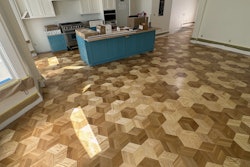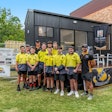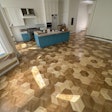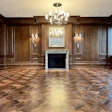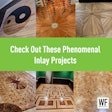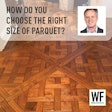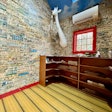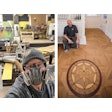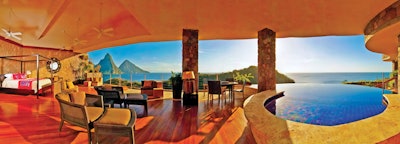
 Jade Mountain “sanctuaries” feature 18 species of wood flooring, like taurino, seen here.
Jade Mountain “sanctuaries” feature 18 species of wood flooring, like taurino, seen here.
 This sanctuary features kabukalli wood flooring. The floor species used in each room also matches the material used to make the sanctuary door.
This sanctuary features kabukalli wood flooring. The floor species used in each room also matches the material used to make the sanctuary door.
Twenty-four luxury hotel rooms and a different tropical flooring species in them all. That was architect and hotelier Nick Troubetzkoy’s vision when he designed the hotel Jade Mountain, a breathtakingly beautiful Caribbean resort perched cliff-side on the island of St. Lucia.
He made it a personal mandate that each room—referred to as a “sanctuary”—would be unique. Besides the flooring, the furniture, art and room shape are also particular to each sanctuary.
The rooms share only two characteristics—they all face the ocean and are missing the fourth wall. That is to say, the sanctuaries are open to the ocean air.
The missing wall presents guests with an unobstructed view of the glassy bay and, in the distance, the Pitons World Heritage Site—two volcanic peaks draped in jade forest. And if that’s not enough, the guests can admire the view while relaxing in their room’s personal infinity pool. Upon entering the sanctuaries, hotel guests are often awestruck.
“It’s a monumental view. I’ve had ladies walk in the door and literally burst into tears,” Troubetzkoy says. “I’ve had architects say, ‘Oh dear, this is totally amazing.’”
The United States Green Building Council agrees. In October, it awarded Jade Mountain a LEED Gold certification—the first Caribbean hotel to achieve the distinction. The certification underscores Troubetzkoy’s commitment to creating a one-of-a-kind, world-class hotel experience. This is how he did it.
Seed of Design
 The stone on the walls inside the sanctuaries and on the hotel’s exterior was sourced on the premises. This sanctuary features taurino wood.
The stone on the walls inside the sanctuaries and on the hotel’s exterior was sourced on the premises. This sanctuary features taurino wood.
The concept for Jade Mountain started as a protest of current trends in hotel design. Get Troubetzkoy talking on the subject, and you’ll hear a tirade filled with the three-letter refrain “TFB.” The top-ranked new hotels in the world? TFB. Their presidential suites, artwork, décor, building materials? TFB, TFB, TFB.
TFB? “Totally. F******. Boring,” he explains, punctuating each word with disdain. “There’s no heart, no soul to it. You might as well stay home. You know, you travel somewhere and you’re in the corridor and it’s like walking into jail. It’s 100 meters long, prison cells on each side, and you throw open the door and it’s TFB.”
In contrast, Jade Mountain was envisioned as an organic building that would reflect and amplify its tropical setting.
The concrete structure is sunken into the side of a steep tropical forest and overgrown with lush foliage. Guests enter their rooms via dedicated open-air catwalks. The building’s walls and floor layouts are freeform, with no corners. Looking up from the water below the hotel, the rooms look like a matrix of caves.
Construction was demanding. The precipitous location made it impossible to deploy concrete trucks, so the steel bar frame was poured with concrete mixed in household-sized tumblers and transported in wheelbarrows. The entire labor force was local, which is a point of pride for Troubetzkoy, a Canadian expatriate who moved to St. Lucia in the 1970s after falling in love with its people.
The hotels in the Caribbean Troubetzkoy would call TFB are typically built by foreigners and are designed to make their owners money—that is to say, according to Troubetzkoy, cheaply. They are cookie-cutter operations against which Jade Mountain is the antithesis.
Sanctuary Floors
 Guests enter their rooms via personal catwalks that tower over the jungle floor below.
Guests enter their rooms via personal catwalks that tower over the jungle floor below.
The wood flooring in the guest sanctuaries is anything but TFB. Troubetzkoy envisioned each of the 24 sanctuaries with its own species of wood flooring and he got close: Eighteen tropical species made their way into the hotel, among them cabbage wood, purpleheart, ebony, bloodwood, monkey pod and more.
“We always wanted Jade Mountain to feel like a natural extension of and a tribute to its island environment and to the Caribbean,” Troubetzkoy says. “That ethos influenced every aspect of the design, particularly when it came to the sourcing and selection of materials to be used.”
The wood was sourced from a sustainable forest operation in Guyana, in South America. For some species, like snakewood, Troubetzkoy had to acquire permission from the Guyanese government. The lumber was milled into ¾-inch-thick, 2½-inch-wide flooring strips in random lengths, then shipped for kiln-drying in Trinidad and installed on-site by St. Lucian woodworkers. Each sanctuary called for around 2,000 square feet of flooring.
Of course, the open-air sanctuaries, vulnerable to the weather and humidity of St. Lucia, posed a challenge for the flooring installers.
That situation was approached from many angles, beginning with the orientation of the hotel itself. The prevailing winds are at the hotel’s back, so rain from tropical storms does not blow far into guests’ rooms. Floor shrinking and swelling is limited by the wood used—the tropical species are dense and not likely to move much, Troubetzkoy says.
The flooring was installed on top of a system of 3-by-4-inch sleepers. The sleepers are spaced 24 inches apart and notched so airflow is not impeded. Circulation is also helped by a system of air vents along the perimeter of the rooms.
The wood flooring ends at the threshold separating the room from the balcony, which is covered in tile installed on an angle to keep water away. A drainage system was installed under the tile for any water trapped beneath.
Troubetzkoy says he experimented with a number of wood floor finishes before he settled on a product used on yachts—a high-sheen exterior marine tung oil finish that he says waterproofs and protects the flooring from harmful UV rays.
“Calling for wooden floors in a situation like that, where you could have rain coming in, was a difficult design concept to process, and we came out successfully without continued maintenance and flooded rooms,” Troubetzkoy says.
The Green Outdoors
 Snakewood, seen in this sanctuary, is one of Troubetzkoy’s favorites. He says it looks like strands of blonde and black spaghetti.
Snakewood, seen in this sanctuary, is one of Troubetzkoy’s favorites. He says it looks like strands of blonde and black spaghetti.
After the building was completed, Troubetzkoy hired a LEED-accredited professional to help him achieve LEED certification. When LEED AP Bruce Poe arrived on site, he says he knew immediately that this project would be certified.
There is a constructed wetland that treats the hotel’s wastewater, and plants grown in that wetland are replanted around the property. There’s an organic farm and a 200-year-old reservoir for collecting and filtering rainwater to be used in the hotel. The adhesives and finish used throughout were low-emitting. The stones and rocks on the exterior were sourced locally. Wood scraps were reused to build visual buffers, like a fence between a public space and a hotel work area. Even sawdust found a use on top of the resort’s many paths.
“This was the greenest project I’ve ever worked on,” Poe says.
In all, Poe was able to secure 43 credits, enough for LEED Gold. But Troubetzkoy wanted Platinum, and the hotel was only a few credits away. He and Poe pored over the credits to see what was left they could achieve.
Unfortunately, they could not acquire the certified wood credit. The wood flooring did not qualify because the operation in Guyana was not affiliated with the Forest Stewardship Council. Poe tried to argue for an exception—he even flew into Washington D.C. to speak with USGBC executives—but the USGBC would not budge, he says.
Poe and Troubetzkoy also looked into installing a photovoltaic power system, but they hit a snag: The credit requires the system to connect to the local power grid, which the St. Lucian government would not allow.
They “settled” for LEED Gold—the first Caribbean hotel to receive the certification—despite Troubetzkoy’s best efforts. “It got to the point where I’m sure the LEED organization said, ‘Oh no, it’s Nick on the phone,’” he says.
Capturing the Beauty
 The building is situated on a steep hillside, which affords guests unparalleled views but created many construction and engineering challenges.
The building is situated on a steep hillside, which affords guests unparalleled views but created many construction and engineering challenges.
For his insistence on providing an incomparable hotel experience, Troubetzkoy’s Jade Mountain has been showered with awards by the travel press.
It made Trip Advisor’s list of the top 10 most romantic hotels in the world, was ranked third best hotel in the world by Travel + Leisure and was ranked best Caribbean resort by Conde Nast Traveler; the list goes on.
For Troubetzkoy, the awards are great, but what he considers the greatest prize is what Jade Mountain gave him—something to devote all of his ideas and energy to, whether that was lobbying the USGBC, mandating the use of more than a dozen tropical wood species or positioning his open-air hanging garden for the view—construction and engineering challenges be damned.
“I prize the spirit of ongoing creation that has for me always been the heart of this beautiful place,” he says. “If we captured a portion of the island’s beauty and quality of life in our work here and can share it with visitors, then I think we’ve done something of real value.”















